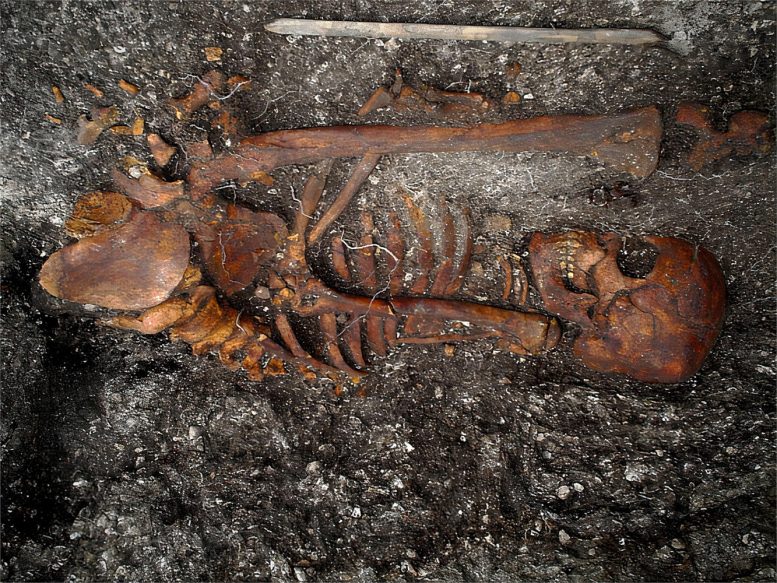
Evidence of syphilis in ancient Brazilian bones disproves the notion that Columbus introduced the disease to Europe, indicating that syphilis-like diseases existed globally long before the 15th century. Above is a skeleton at the site in Jubuicabeira II, Brazil. Credit: Dr. Jose Filippini
Scientists from the Universities of Basel and Zurich have identified the genetic traces of the bacterium Treponema pallidum in the skeletal remains of individuals who passed away in Brazil around 2,000 years ago. This finding represents the most ancient confirmed detection of this bacterium to date. It confirms that humans were afflicted with conditions similar to syphilis, referred to as treponematoses, well before Columbus’s discovery of America.
The new findings, published in the scientific journal Nature, call into question previous theories concerning the spread of syphilis by the Spanish conquistadors.
The history of the emergence and spread of infectious diseases was of great importance for global health even before the Covid-19 pandemic. With modern laboratory methods, researchers can now detect the tiniest traces of DNA from pathogens in prehistoric finds. That means they can trace back how these pathogens spread historically and their evolutionary development.
An international research group led by Professor Verena Schünemann from the University of Basel, formerly at the University of Zurich, in collaboration with ETH Zurich and the Universities of Vienna and Sao Paulo, examined prehistoric bones belonging to four individuals who died 2,000 years ago in the coastal region of Santa Caterina in Brazil. For some of the individuals visible pathological changes to the prehistoric bones were detected which could indicate that the deceased were suffering from an illness similar to syphilis.
Prehistoric DNA from bones dating over 2,000 years old
The researchers used dentists’ drilling tools to remove minuscule samples of bone under sterile conditions. From those samples, they isolated prehistoric genetic material (ancient DNA) belonging to the syphilis pathogen. Their study, published in the renowned scientific journal Nature, demonstrates that all the bacterial genomes that have been investigated can be attributed to the Treponema pallidum endemicum strain – that is, the pathogen that leads to bejel.
Treponematoses are a group of infectious diseases that include the sexually transmitted disease syphilis. While syphilis as a venereal disease presents a global health risk, bejel, which is spread by skin contact, only occurs today in very arid regions of Africa and Asia.
“Our study has been able to show that endemic syphilis was already present in humid zones of Brazil around 2,000 years ago,” says Schünemann. This means that people were already becoming infected with endemic syphilis, probably via skin contact, more than 1,000 years before the arrival of Columbus in the New World.
Syphilis-like diseases originated pre-Columbus
Intense debates are still ongoing today among specialists and medical historians concerning whether Christopher Columbus’s sailors and soldiers brought sexually transmitted syphilis from the New World to the Old upon their return in 1492. The illness spread rapidly from the end of the 15th century onwards, particularly in harbor towns.
“The fact that the findings represent an endemic type of treponemal diseases, and not sexually transmitted syphilis, leaves the origin of the sexually transmitted syphilis still unsettled,” says Kerttu Majander, postdoctoral researcher at the University of Basel and one of the lead authors of the study. However, the authors consider that there is a lot to suggest that treponematoses were already widespread in Europe before Columbus’s time.
“As we have not found any sexually transmitted syphilis in South America, the theory that Columbus brought syphilis to Europe seems to appear more improbable,” agrees Schünemann. In point of fact, earlier discoveries by her group, for example in Finland and Poland, suggest that some forms of treponematoses already existed in Europe too.
Recombination could have driven the development of syphilis-like diseases
Many species of bacteria exchange traits that are of evolutionary benefit via what is known as horizontal gene transfer, or recombination. A comparison between the prehistoric DNA in the bones from Brazil and today’s pathogens shows that such recombination events have indeed taken place. “We cannot pinpoint exactly when this exchange took place, but it is probably one of the driving mechanisms in the divergence between the subspecies that cause different treponemal infections,” says Marta Pla-Díaz of the University of Basel, the other lead author of the study.
The DNA comparison also allows the date of the Treponema pallidum family’s emergence to be deduced. Their investigations show that these pathogens have arisen at some point between 12,000 and 550 BCE. The history of these pathogens therefore stretches much further back than previously assumed.
“Although the origin of syphilis still leaves room for imagination, at least we now know beyond a doubt that treponematoses were no strangers to the American inhabitants who lived and died centuries before the continent was explored by Europeans,” concludes Schünemann. She and her team are confident that advances in the analysis of prehistoric DNA could also lead to the discovery of the origin of venereal syphilis.
Reference: “Redefining the treponemal history through pre-Columbian genomes from Brazil” by Kerttu Majander, Marta Pla-Díaz, Louis du Plessis, Natasha Arora, Jose Filippini, Luis Pezo-Lanfranco, Sabine Eggers, Fernando González-Candelas and Verena J. Schuenemann, 24 January 2024, Nature.
DOI: 10.1038/s41586-023-06965-x









This strikes me as being a distinction without a difference. The inhabitants of the New World may have developed a natural immunity to syphilis, and been asymptomatic. The well documented European epidemic, “The illness spread rapidly from the end of the 15th century onwards, particularly in harbor towns” is strong evidence that Columbus brought something back from the New World. It is also known that syphilis was extremely virulent in the beginning, but became less so over time, which is a behavior observed in other diseases that kill their hosts before it can spread. So, whether syphilis was already an asymptomatic disease in the New World, or it mutated after being transmitted to Europeans, it is probably not a coincidence that it was a serious problem in Europe after 1492.
Spread by skin contact rather than bodily fluids sounds like HSV/herpes
“However, the authors consider that there is a lot to suggest that treponematoses were already widespread in Europe before Columbus’s time.”
Not too surprising given that we now are confident that at least Vikings made it to the New World before Columbus did. They may have acquired a different strain of what we now call syphilis, or had natural immunities that those from Spain didn’t have.
“… we now know beyond a doubt that treponematoses were no strangers to the American inhabitants who lived and died centuries before the continent was explored by Europeans,”
This is not a compelling argument that Columbus’ expedition didn’t bring something back from the New World that we now call syphilis.
And so another myth proves to be debunkable. So we Europeans only murdered those whose land we had invaded (normal human practice since H sapiens wiped out the Neanderthals and probably other co-existing hominids such as H erectus) and gave them smallpox, influenza (perhaps) and strong drink. We didn’t give them VD. That’s OK.